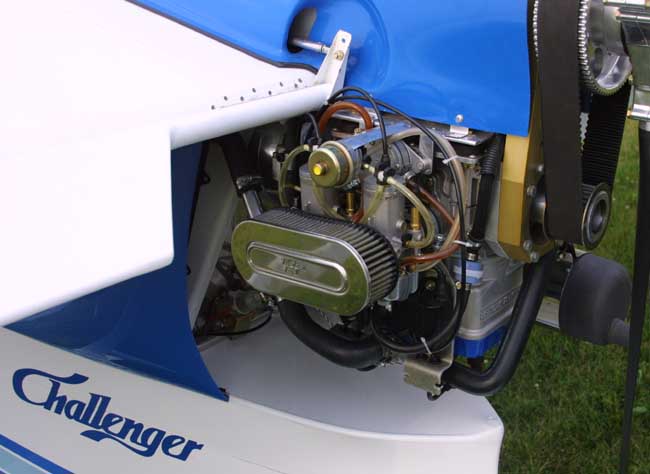|
The Challenger has used several engines over the years. These include the
KFM, Rotax
277/447/503 and the Hirth line.
KFM
The KFM engine was originally used on the single place Challenger. It is a two-cylinder
opposed engine using a belt reduction drive and came with electric start. Unfortunately it
had a history of overheating and engine failure caused by seizure. Another reported
problem was crankshaft failure. It has also been a problem to obtain parts and service for
the KFM engine.
HIRTH
Problems reported with the use of Hirth engines on the Challenger include overheating,
crankshaft failure, and ignition failure. Another common problem has been with failure of
the needle in the Bing carburetors, and failure of the rubber intake sockets. The
most-reported problem is the availability of parts, service, and reliable troubleshooting
information for the Hirth engines. (See
"Hirth vs
Rotax" in the Buzzword Section)
ROTAX
Rotax 277: The 277 Rotax engine is one of the most trouble free used in
ultralight aircraft application. Its main reported problems when used on the Challenger
are usually not the engine's fault, but the result of poor installation in the field.
Engine overheating resulting in failure has been a commonly reported problem when using
the free air model of the 277 Rotax on the Challenger. This can be traced to insufficient
airflow around the cylinder during flight. This leads to the overheating problem. A simple
solution is to duct more air around the cylinder, and not to allow the engine to idle for
long periods on the ground.
Another reported problem is with failure of the liner used to support PTO crankshaft
bearing in the crankcase. This failure is caused by overtightening of the reduction drive
belt. This overtightening causes the plastic bearing line, which supports the bearing to
loose its shape. This then allows the crankshaft to move in the liner. This movement can
cause and engine failure and will usually damage the magneto!
Rotax engine troubleshooting on the Challenger
Rotax 377/447/503: The biggest problem reported with the use of these engines on
the Challenger has been crankshaft failures. These failures can be attributed to the using
the Rotax engine in an inverted application and the use of the belt drive system supplied
standard on the Challenger.
When the Rotax 337/447/503 are used in an upright installation, a gravity feed system
is used to supply oil to the crankshaft main bearings through channels in the crankcase.
While oil is still supplied to these bearings in an inverted engine, it is being supplied
by internal engine pressure rather than gravity.
When the upright engine is left in storage, oil flows down into the channels in the
case coating the crankshaft bearings. In an inverted installation, this oil flows AWAY
from the bearings.
On start up, this lack of oil can lead to premature bearing failure.
Before starting an engine that has been left in storage, it is recommended that the engine
be turned over for several revolutions with the ignition turned OFF to bring oil back up
into these bearings.
When a two stroke engine is stored in an upside down installation oil will gravitate
down into the ring area. This excess oil will generally foul spark plugs and can lead to
premature ring seizure. This ring seizure is caused when the engine is started up and the
heat from the combustion chamber bakes the oil around the ring lands, causing carbon
build up. This oil can also cause premature wrist pin bearing failure. Oil collects inside
the dome of the piston and is ignited by the heat of combustion. The residue then flakes
off and can enter the wrist pin bearing.
Crankshaft bearing failure appears to be more common when a belt drive system is used
on the Rotax engine. Of the over 50 Rotax air cooled aircraft engines I rebuilt last year,
only 4 had failed crankshaft end bearings. These 4 engines were on Challengers using belt
drive systems, while the other engines were using the standard Rotax gear drive. While the
other engines had 200 to 300 hours of use all the Challengers engines were less than 150
hours.
In two of these 4 cases the crankshaft had also broken in half. This was caused by the
failure of the two end bearings and the pilots continuing to fly their craft. This is like
a runner continuing to run with a broken leg!
Among other items that have been reported entering the prop are parts of the exhaust
springs and upper and lower engine cowls. All of the exhaust springs should be SAFETY WIRED AND THEN FILLED WITH SILICONE. This
will hold the spring together if it fails.
Some Challenger owners have reported the air filter coming off the carburetor in flight
and striking the prop. It is suggested that a small hole be drilled in the back of the
carb and front of the airfilter and that these holes be used to safety-wire the air filter
to the carburetor. As an additional safety measure, the carburetors can then be
safety-wired to the engine itself.
If you notice that your aluminum engine cowls are starting to crack, replace them with
a STEEL COWL. To date I have no reports of the steel cowl failing. Another reported item
that has entered the prop is the screws and washers holding the upper and lower cowls
together. A dab of silicone over the washer and screws will prevent this from happening.
One final area of concern on the engine is the fan tower. Challenger owners have
reported failures of the tower at the webbing supporting the fan blades and at the four
bolt holes that hold the fan tower onto the crankcase.
Also check out Troubleshooting the Rotax engine series vol
1
Also check out Troubleshooting the Rotax engine series vol 2
Also check out the Challenger upright
engine mount.
Also check out this tech tip for checking the fan belt adjustment on
a 503. |


